Creative writing can be a mind-blowingly stressful occupation that requires a herculean amount of effort, mental expenditure and a painstakingly long amount of time, inducing even the finest imaginative to succumb to a full-blown meltdown. Now I’m no Tarantino but believe me this is true- and the worse part of all, well, it’s all self-inflicted.
So, who in their right (or wrong) mind would even consider making this their profession? Or, even worse, could have the outright gall to suggest that this psychological behemoth is their side hobby: meet Joe Jones.
Over the last month, Leytonstone resident Joe has allowed me – better described as ‘put up with me’ – into a self-made screenwriting universe, where the restraints of real-life rules, societal standards, physics and just about anything you can think of that dumbs down the fun of our own lives do not apply.
Generously taking me on as his understudy, I submerged myself into this brilliantly outlandish topic, exploring the internal motivations behind pursuing such a challenging career and even stumbling upon a few surprises of my own- all while the recent graduate attempted to produce a fully-fledged first film script. Here’s how it went.
First Week On The Job
My first order of business as a budding screenwriter was to enquire about the route taken into the business by my subject, educating myself on the fundamental tools needed to produce the next Hollywood blockbuster, and of course the best way to do this would surely be binge-watching Netflix all day… or so I thought.
What I actually had to put myself through shook me to the core. Reading. Yes, an entire 195-page book. The problem being my only prior hardback text encounter came in the form of ‘The Diary Of A Wimpy Kid’ collection books in school. Challenge, begrudgingly, accepted.
‘Save The Cat!’ by Blake Snyder would be the recommendation of choice by Joe, describing it as “the best and most popular beginners guide.” And under my new boss’s watchful prescription glassed eyes, it dawned on me: I genuinely had to read it.
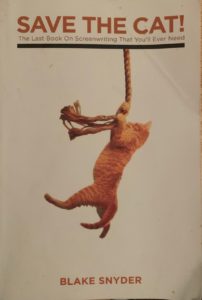
As I started flicking through the first few pages, expecting to be bombarded with text and information that would completely override my internal CPU, a very strange feeling started to take over. I was having fun. Snyder, just as Jones said, was able to “tell you how to turn ideas and premises into actual engaging stories” in such a simplified and efficient way that I somehow finished the book in just two sittings.
‘The Same But Different’
‘The same but different’ is a phrase coined in the book that suggests that most successful films have the same story told just ever so slightly differently, be that a small twist or an entire separate genre. With this information at hand, I probed my supervisor for answers on what examples of motion pictures follow this engrained blueprint.
“Buddy comedies. ‘Dumb And Dumber’ and ‘Bad Boys’. They seem like different premises, one’s action and one’s comedy. What it essentially boils down to is: two friends are working together; then they have to go and do something together; they’re trying to get it done together but at some point down the road they have a falling out (or something gets in the way) and they have to fix that issue before they can fix the overall problem.”
Meticulously deciphering and breaking down the prototype for this genre sent me down a very dark rabbit hole, one that at long last hadn’t been courtesy of YouTube’s impressive insomnia inducing algorithms. In fact, as of today, I remain incapable of watching a flick without completely overanalysing every minor detail in the process, thus ruining many of my beloved childhood classics- ignorance really is bliss.
Horror, comedy, action, romance, western – not to offend any potential 15th century readers and their most memorable renditions of Hamlet, but, yeah, even Shakespeare did it – the list goes on. Perhaps the guiltiest of them all, the one that Joe has the biggest gripe with, comes from one of the largest studios in the world, or should I say multiverse? Marvel.
Modern Marvel
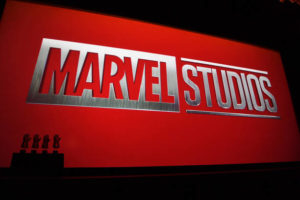
Now, before you all get your pitchforks out, or you summon the supernatural strength in a fit of cancelling rage to pull your replica Comic Con Thor hammers out from the untidy ground from which it lays, please just take a minute to hear him out.
“When you go to a Marvel film, you know exactly what you’re going to get. It’s going to start with the superhero of choice, and at some point, he’s going to come into contact with a malevolent villain.” So far so good, we can all admit this is true.
“The villain will then try and get up to something, and the superhero will try and stop him. Then the villain will send his minions and the hero will dispatch them with ease. Then, the superhero will take a small defeat to the villain and will have to do some kind of personal soul searching, once he’s done that, he’ll go back and defeat the villain and save the world.”
Boom. The layout to just about every single Marvel film ever made – in the case of ‘Spiderman’, the layout for the film made, remade, remade again and then given a complete makeover by a completely different studio, just, you know, without any actual makeup. Apart from ‘Black Panther’. Joe likes Black Panther. Okay, fine, he likes many Marvel movies, but that doesn’t emphasise my point.
Why Does It Work?
There’s no shame, in accepting that, yes, our favourite superhero may have: a cool five starred shield that glorifies the tired rhetoric of being a real American patriot through theatre. An anger issue so out of control that they turn into a tie-dyed descendant of the green giant, where instead of consuming sweetcorn, they’re inhaling steroids and destroying everything in its path. They’ve suffered a bite from a radioactive spider so venomous that it allows them to bend the law of superhero films and change entire studios. Or some good-looking bloke in an iron suit that has a lot of money.
All jokes aside, when we really map out the narrative and structure of each individual film, they are in essence, whether you like it or not, the same human concept- an escape from reality. And they’re pretty damn good.
“People like their films like that, they know they’re going to be entertained and they know they’ll laugh.” The formula really is that simple, give people what they want. If you go to a comedy show, are you looking for deeper critical commentary on the meaning of life? No, you’re looking to laugh.
If Marvel is providing people with an afternoon’s worth of entertainment that satisfies viewers enough to go home feeling 100% affirmed in their decision to spend 10 full British pounds on an ice blast and some below par popcorn, then I say keep the Spiderman’s coming- it is still Marvel, right? Just for the love of god, don’t tell Joe.
14 Days In
We’re here. The halfway mark. If you’re still reading up to this point, then I’m assuming you want a few bits of inside knowledge and tricks used by the most successful writers, filmmakers and directors to gain an upper hand over the competition. So did I. Luckily for me, the quickest promotion of my life was about to occur.
After 14 endless days of patiently waiting for Joe to finish ranting about his distaste for Tom Holland as Peter Parker, it was time to move on. I’d be invited to sit in on one of his renowned writing sessions, in his very own private office. The big leagues.
A Day In The Office
Infiltrating such a place meant looking the part, so I did what any creative in this godforsaken hell hole of a Capital does to give themselves a sense of importance, charged towards ‘Pret A Manger’ to pay an extortionate price for a latte. I even added some caramel syrup for 30 pence- this was serious. Of course, I kept hold of my empty branded cup, just so people finally recognised me as a meaningful member of society.
Upon arrival, where a much-needed ‘Yorkshire Tea’ welcomed me at the door, my mind was struggling to keep up with its own caffeine infected trail of thought. I couldn’t stop thinking what was inside that office.
A copious amount of space with an estimated market value of £600 per calendar month? Equipment and software so advanced that the code for the screenplay text would need to be cracked by Alan Turing himself? What I actually discovered once those doors swung off their hinges was a very welcomed sight. Simplicity.
Sorry to disappoint you – admittedly I built up this amount of suspense on purpose – but Joe’s luxurious private office is a just a spare room in his flat. As a matter of fact, it’s what the living room space was meant to be, turns out, like every block of condensed London property, there wasn’t much room for living.
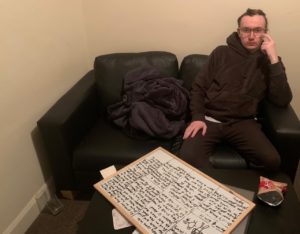
As we both perched our backsides onto the black leather two-person sofa that had been perfectly pressed into either side of the wall, leaving a symmetrical paint-stained white mark across its outline that Mike Dean would be proud of, I noticed a whiteboard.
On the board were segments to Joe’s story all divided up into small individual parts. There was even a little doodle to go with it, the less said about that the better. ‘What is this?’, I asked.
The Storyboard Secret
“What that is, is a storyboard. The purpose of that is trying to compartmentalise a very, very important scene within a screenplay. Some writers do that with every single scene, some people use cards.”
See, I promised there was going to be some sort of educational value from ploughing through this huge written piece of work, you’re welcome. So, how’s it used?
“You essentially move around different bits that happen in a scene and see what fits best. The ones that are really important to the progress of the story, I like to do that for. That lets you visualise what’s going on and get it separate from what you’re writing in the screenplay. By separating the two, taking the scene out of the screenplay, you understand it better and you can then slot it in nicely into the story.”
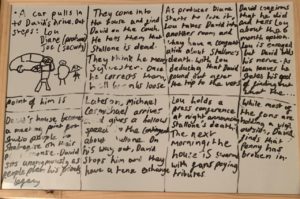
It seems like a really easy trick, one which you couldn’t imagine taking much thought or effort. Well, for your amusement, I tried giving it a go. The results came back within 15 minutes of being ushered off with a permanent marker in hand, thinking of a scene to divide up into its most crucial developmental parts. The result? A temper tantrum and a blank board. It’s harder than it sounds, trust me.
Yet, this is what the majority of big shot screenplay writers do. Obviously, they get more than a measly 15 minutes, most of them get years. They’ll write up the base of a scene onto their cue cards and not come back to it for weeks at a time, as if they’re allowing their thoughts to reduce in their own impressively imaginative juices. Something I wasn’t allowed to do.
Using the storyboard technique, Jones’ script had finally started to take shape at around week three. This probably would have been a lot sooner, although I don’t think other famous screenwriters out of Leytonstone had an annoying, private space invading buffoon like myself following their every move. Then again, who has a clue what type of people Alfred Hitchcock was knocking around with. If Psycho is anything to go by, I’d rather not know. Anyway, here’s what we’ve all been waiting for.
The Script
Right, here it is, what this entire month-long expedition has all been for. The script. Just before we get into the nitty gritty of it all, I’d just like to take a moment to express my sincere appreciation towards Joe for the last 30 days, granting me permission to invade his entire life and welcoming me with open arms while doing so, or should I say paws.
Okay, here it really is, the script is titled: Detective Dog. Do you see what I did there?
What Is It?
To quote ‘Save The Cat!’ one last time and wrap this whole thing up, “’What is it?’ is the name of the game. ‘What is it?’ is the movie. A good ‘What is it?’ is the coin of the realm. Everyone, all across town is trying to wrap their brains around the same question your friends were asking on Saturday night: ‘What is it?’. And if they can’t, they’re toast.”
A good ‘What is it?’ comes from the logline, a one sentence summary that captures what the film, series or theatre performance is. If you go onto any livestreaming service, such as ‘BBC iPlayer’, you’ll see a logline next to your favourite TV licensed show, which there aren’t many for me-allegedly.
So, Joe, in one sentence, ‘What is it?’
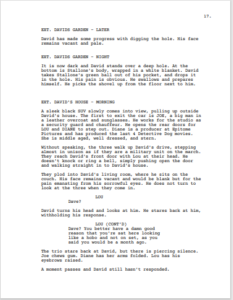
“The trainer of the worlds biggest canine movie star has to reinvent himself when the canine movie star dies.” Depressing, yet summed up perfectly. Expected to be finished “by Christmas day”, I’ll be sure to keep my eyes peeled for an early emailed present.
Having said all that, the last month has reinforced a passion inside myself that had been getting dimmer and dimmer over the past few years – creativity. Inspiration was the last thing I thought would be gained from this whole experience, yet here I was, inspired.
Yes, productive activities are at times incomprehensibly hard, and it only feels nice when you get it right, but when it’s as good as it can be, nothing else compares. Good luck Joe, I’ll be keeping a look out.



